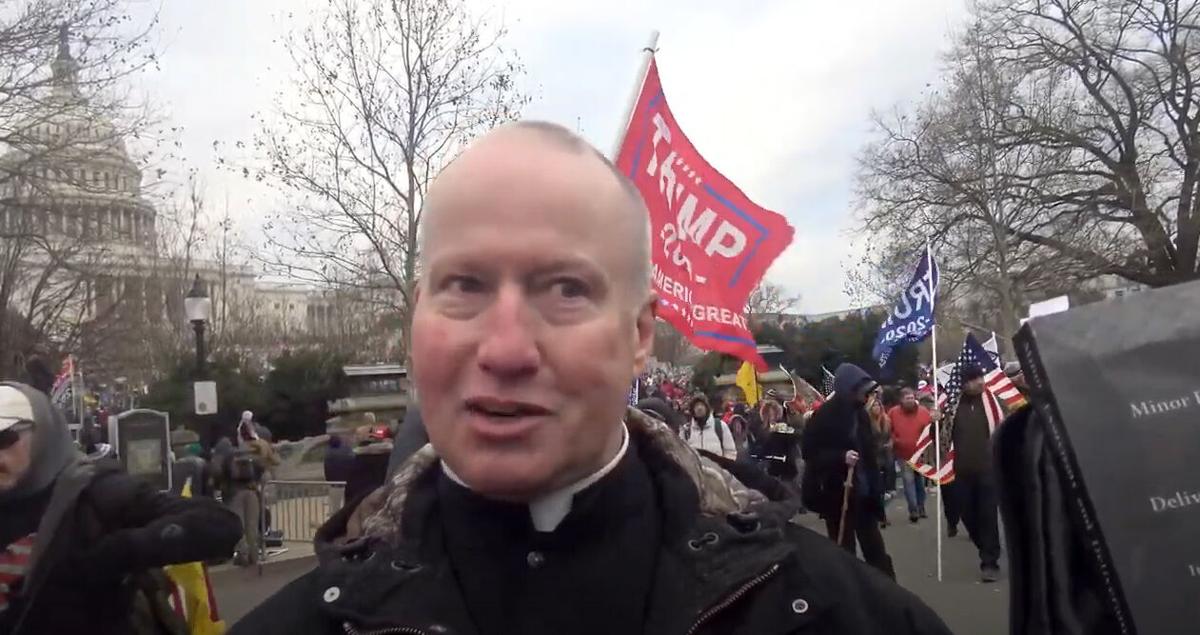So Jacob Chansley, the LARPer labelled the QAnon Shaman (though he no claim to any lineage or training that’d entitle him to the latter appellation) has a brother in arms, David Fulton, a Catholic priest who performed an “exorcism” of the “demon Baphomet” during the anti Democracy terrorist attack on the Capitol building January 6. He’s been publicly condemned by his archbishop and his parishioners are calling for him to be defrocked. Catholic authorities point out that Fulton has never been trained or authorized as an exorcist – a gig that the Church believes in and takes very seriously. Moreover, “Baphomet” does not appear in any serious rolls of demons on record. In other words – another LARPer pretending to spiritual knowledge and power that he is in fact clueless about. An excerpt from the Omaha World News who broke this story says:
“In the video, Becker asks Fulton if he performed an exorcism at the Capitol. Fulton responds, “Yes, I did.” Becker then asks what it was like and Fulton says, “We’ll see, we’ll see what effect …”
“Fulton goes on to talk about a demon that has possessed the Capitol and satanic cults that he said he learned about on YouTube.
“Ripperger himself has Nebraska ties. He spent a year at Immaculate Conception Church in South Omaha, went to St. Gregory the Great Seminary in Seward for four years, then taught at Our Lady of Guadalupe Seminary in Denton for six years, according to biographical information about him on a church website. The seminary in Denton is the main seminary in the United States for the Priestly Fraternity of St. Peter.”
Read the entire piece which includes a video inteview done with Fulton on January 6 in Washington, DC
Wikipedia says:
The Catholic Church authorizes the use of exorcism for those who are believed to be the victims of demonic possession. In Roman Catholicism, exorcism is a sacramental[1][2] but not a sacrament, unlike baptism or confession. Unlike a sacrament, exorcism’s “integrity and efficacy do not depend … on the rigid use of an unchanging formula or on the ordered sequence of prescribed actions. Its efficacy depends on two elements: authorization from valid and licit Church authorities, and the faith of the exorcist.”[3] The Catechism of the Catholic Church states: “When the Church asks publicly and authoritatively in the name of Jesus Christ that a person or object be protected against the power of the Evil One and withdrawn from his dominion, it is called exorcism.”[2]
The Catholic Church revised the Rite of Exorcism in January 1999, though the traditional Rite of Exorcism in Latin is allowed as an option. The ritual assumes that possessed persons retain their free will, though the demon may hold control over their physical body, and involves prayers, blessings, and invocations with the use of the document Of Exorcisms and Certain Supplications.
Solemn exorcisms, according to the Canon law of the Church, can be exercised only by an ordained priest (or higher prelate), with the express permission of the local bishop, and only after a careful medical examination to exclude the possibility of mental illness.[4] The Catholic Encyclopedia (1908) enjoined: “Superstition ought not to be confounded with religion, however much their history may be interwoven, nor magic, however white it may be, with a legitimate religious rite.” Things listed in the Roman Ritual as being indicators of possible demonic possession include: speaking foreign or ancient languages of which the possessed has no prior knowledge; supernatural abilities and strength; knowledge of hidden or remote things which the possessed has no way of knowing; an aversion to anything holy; and profuse blasphemy and/or sacrilege.
The first official guidelines for exorcism were established in 1614,[5] whereas grimoire were widely known and used since the Ancient period. Those guidelines were later revised by the Vatican in 1999 as the demand for exorcisms increased. In the 15th century, Catholic exorcists were both priestly and lay, since every Christian was considered as having the power to command demons and drive them out in the name of Christ. These exorcists used the Benedictine formula “Vade retro satana” (“Step back, Satan”) around this time. By the late 1960s, Roman Catholic exorcisms were seldom performed in the United States, but by the mid-1970s, popular film and literature revived interest in the ritual, with thousands claiming demonic possession. Maverick priests who belonged to fringes took advantage of the increase in demand and performed exorcisms with little or no official sanction. The exorcisms that they performed were, according to Contemporary American Religion, “clandestine, underground affairs, undertaken without the approval of the Catholic Church and without the rigorous psychological screening that the church required.” In subsequent years, the Church took more aggressive action on the demon-expulsion front. The practice of exorcism without consent from the Catholic Church is what prompted the official guidelines from 1614 to be amended. The amendment established the procedure that clergy members and each individual who claims to be impacted by demonic possession must follow. This includes the rule that the potentially possessed individual must be evaluated by a medical professional before any other acts are taken. The primary reason for this action is to eliminate any suspicion of mental illness, before the next steps of the procedure are taken. Since demonic possession was extremely rare, and mental health issues are often mistaken for demonic possession, the Vatican requires that each diocese have a specially trained priest who is able to diagnose demonic possession and perform exorcisms when necessary.”[6]
https://en.wikipedia.org/wiki/Exorcism_in_the_Catholic_Church


